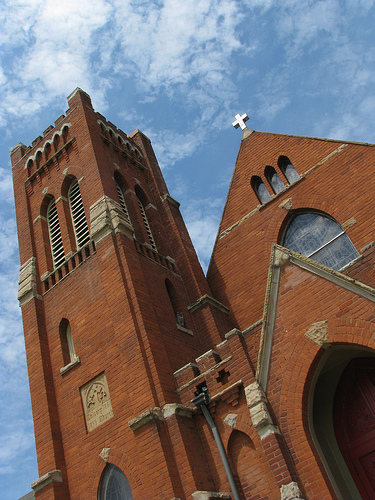 |
| Calvary Episcopal Church – Ashland, Ky. |
Thomas Underwood Dudley, the second Bishop of the Episcopal Diocese of Kentucky, emphasized growth among the Episcopal church among the populations in eastern Kentucky and among African Americans. Despite the segregationist views prevalent in his day (and his own background as a Confederate veteran), Bishop Dudley sought an integrated church: “God hath made of one blood all nations of men.”
Efforts to grow the Episcopal Church in eastern Kentucky included the first recorded service in Ashland being presided by Bishop Dudley on February 2, 1885. From that service, a mission was formed in the diocese and from this group grew the Calvary Church. In March 1887, the Rev. W. H Hampton was called as the first minister of the parish. On September 8, 1888, Bishop Dudley laid the cornerstone and Rev. Hampton preached the first sermon in the Calvary Church which opened on Easter Sunday, 1889 for a congregation of 300. Architectural notes are limited, but this structure was described as an “eclectic brick and shingle” church.
Growth continued in the Ashland church and throughout the diocese, which as divided in 1896 with the Ashland church joining the newly formed Diocese of Lexington. Several transitions occurred during this diocesan split including the transfer of the Ashland School for Girls to Versailles where it became the Margaret Hall Church School for Girls. Disappointed at losing the school, the parish rector also departed in May 1898.
On July 3, 1898, Calvary’s first rector – W. H. Hampton – returned from Ironton, Ohio to administer the Holy Communion. Eight days later, the darkest days in the church’s hour came when the church was destroyed by fire. Only a few furnishings were salvageable.
Remarkably, a new cornerstone was laid ten days later. In June 1903, the new church was dedicated by the Bishop Burton of the Lexington Diocese. The building, a brick and stone Gothic structure, dominates its corner at Winchester Avenue and 14th Street. With its three story tower, stonework, battlements, and lancet window, the church building is traditionally Episcopalian.
A brick parish hall was built immediately to the sanctuary’s northwest after a 1979 fire caused $1 million in damage to a building donated to the church in 1975. Another fire struck the church in 1982. Despite its setbacks, the church remains strong as it searches for its new rector.
“It is a beautiful church, inhabited by a charming and cultured people and set in the midst of delightful surroundings.”
-H. P. Almon Abbott (1938)
Sources: Calvary Church; EpiscopalKY; Fiftieth Anniversary Church History (1938); Kentucky Historic Resources Inventory; NRHP Application (Ashland Commercial Historic District) Sunday Independent (11/16/1987). Special thanks to Marty Perry of the Kentucky Heritage Council and Lisa Pullem, the Convenor of Calvary’s Rector Search Committee, for their assistance in gathering the research for this post.
